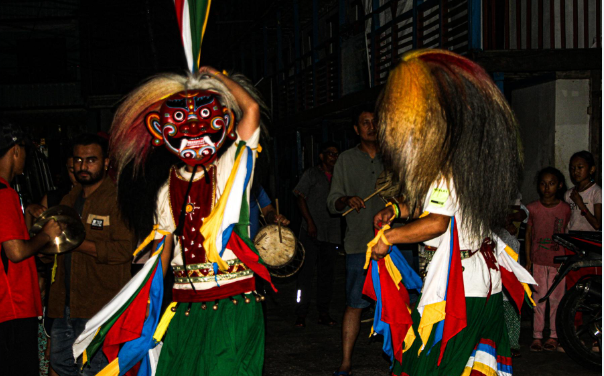The Lakhe Jatra for this year has successfully concluded. The festival, which began with a special event at the Bhimsen Temple in Bhintuna Danda, Taplejung on Nag Panchami, wrapped up on Krishna Janmashtami.
Organized under the auspices of the Nepal Language and Cultural Society, the festival has been a long-standing tradition in the district’s headquarters, Phungling. According to Shankar Shrestha, the society’s president, the event featured performances depicting the battle between Lakhe and Krishna, culminating with Krishna’s victory over Lakhe around 10 p.m. on Tuesday.
The Lakhe Jatra commenced with formal worship of the traditional instruments used in the festival, such as drums, bhyamta, and mukhundo, alongside other materials like the attire worn by Lakhe. The festival’s activities were designed to reenact the battle between Lord Krishna and his uncle Kamsa, reflecting scenes from the Dwapar Yuga.
The festival is an integral part of Nepal’s cultural heritage, especially significant to the Newar community. It is celebrated in districts with Newar populations, including Taplejung. Lakhe dance, the main attraction of the festival, features performers in frightening masks symbolizing evil spirits. The festival is traditionally celebrated during Janai Purnima, Gai Jatra, and Indra Jatra with great enthusiasm.
According to research by Ganesh Ram Lachi, various legends surround the origins and history of the Lakhe Jatra. One popular tale describes a massive demon, Lakhe, that once terrorized the Kathmandu Valley. The gods defeated this demon, and the mask was later used to symbolize the triumph over evil in a cultural festival. Through the Lakhe dance, the message of overcoming malevolent forces is conveyed to the public.
While primarily associated with the Newar community, Lakhe Jatra holds cultural significance for the entire Nepali society. The festival fosters respect for local deities, preservation of cultural heritage, and a sense of unity among communities.
The Lakhe dance is the festival’s highlight, featuring participants dressed as demons with large, fearsome masks and elaborate costumes. The aggressive and dynamic style of the dance is believed to ward off evil spirits, creating a unique and mysterious atmosphere during the festival.
Lakhe Jatra is not only a religious event but also serves to promote unity and goodwill among participants. Despite its significance to the Newar community, the festival garners interest and participation from various communities, promoting inter-cultural respect and coordination.
In recent times, the significance of Lakhe Jatra has waned due to increasing urbanization, the influence of Western culture, and modern entertainment options. Urbanization has also posed challenges in organizing the festival comprehensively.
Nevertheless, efforts are being made by various organizations, particularly Newar ethnic groups, to preserve the festival. There is a need for collaboration between local communities and the government to promote and sustain this cultural heritage.
Lakhe Jatra remains one of Nepal’s traditional festivals, strengthening religious faith, cultural identity, and community cohesion. Through this festival, Nepali society not only preserves ancient customs but also advances the campaign for cultural revival.






